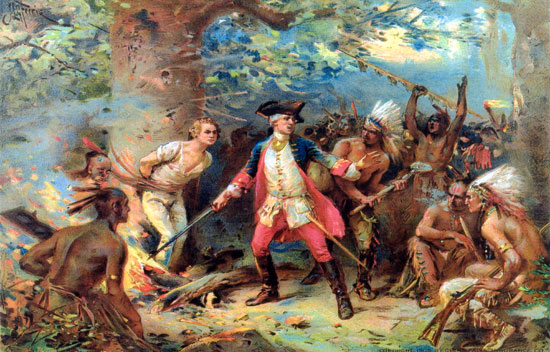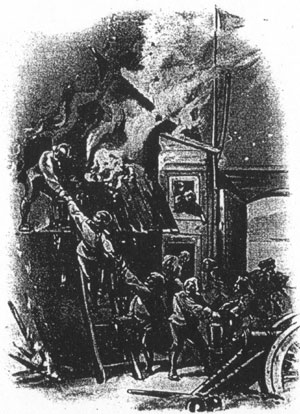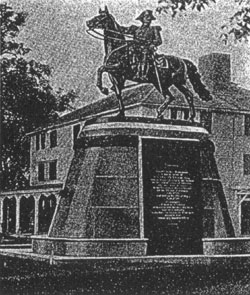| |


Putnam Saving Fort Edward
Israel Putnam with his characteristic indifference to danger and persistency of
purpose, saved Fort Edward not long after it was built, from a fire which for
an hour and a half desperately threatened its magazine. Placing himself in
the most dangerous place, he rallied the garrison to his aid, and although
considerably burned he rendered very great service as a fire-fighter in saving a
fortification of great importance to the Colonies at that time.
|
The local "by-product," so to speak, of thrilling incident pertaining to the French
War, with its many important events occurring in the vicinity of where Glens
Falls now is, is very abundant. The one which was selected for the Glens
Falls Insurance Company's 1906 issue of its series of historic Calendars
is from the life of Major Israel Putnam, showing how nearly his afterward conspicuous
and important services came to being lost to the Colonies.
Immediately following the humiliating failure of Abercrombie's expedition against
Montcalm at Ticonderoga and Abercrombie's retreat to the head of Lake George, the
alert Montcalm sent out parties to cut off the English supplies necessarily transported
overland from the head of the Hudson River navigation at Fort Edward to Lake George,
and to harass the English generally.
To oppose one of these marauding expeditions of some 500 French and Indians,
a Fort Edward force of 600 or 700 went out under the noted partisan ranger, Rogers:
Major Putnam
went with them.
Marching in single
file by a narrow
woods path, Putnam leading, they
suddenly came
under fire of the
hidden enemy. A
powerful Indian
sprang upon Putnam, whose gun
missed fire, and being overpowered
and bound to a tree,
he remained helpless between the
hostile firing of an
obstinate engagement, bullets striking the tree to
which he was bound
and even piercing
his clothing. The
French and Indians
were compelled to
retire, taking' Putnam with them,
while Rogers remained on the field
of battle to bury, the
dead and remove
t he wounded to
Fort Edward.
Putnam, being
the captive of the
Indians, was subject to their malignant savagery.
Stripped of most of
his clothing, clubbed and even wantonly wounded on
the cheek by a tomahawk, his bare feet
bleeding, heavily laden and with
swelling wrists from
the tightness of
cords, his torture
was so severe that
he begged the mercy
of being killed. Finally a French officer untied his
hands, took off part of his
burden and provided a pair of
moccasins.
Not being pursued, the
party camped for the night
and the Indians prepared for
a savage entertainment. Putnam was bound to a tree, to be
tortured to death by fire. A
summer shower extinguished
the first fire started. but being lighted again the Indians
began shouting and dancing
around their victim. The suggestive yells of the war-dance
were heard by the French leader, Marin, or Molang,
who hastened to and through
the fiendish crowd, scattered the burning brushwood which
was about Putnam, cut him
loose and upbraided the sullen,
disappointed savages for their
cruelty.
This timely and dramatic
rescue is illustrated above, from an
oil painting by Mr. Ferris
owned by the Glens Falls
Insurance Company.

The Putnam Monument, Brooklyn CT
The monument faces the east and the field where Putnam
"left his plow" when he heard and instantly responded to the
cry from Lexington, and near the little tavern which he kept.
His remains now rest beneath this monument. |
The exhausted and suffering captive was then secured,
Indian fashion, for the night
by tying his hands and feet to
separate saplings and laying
long, slender poles across his
body, on the ends of which
Indians slept, to be awakened
by his slightest stir. The next
day he was taken to Ticonderoga and thence to Canada,
enduring hardship and suffering with horrible outrages during captivity – the scars from which he carried to his grave.
He was finally released by the friendly influence of Colonel, afterwards General,
Schuyler.
Previous to this incident, Major Putnam had been with Colonel Williams in the
"Bloody Morning Scout," September, 1755, in the battle of Lake George which followed,
and with Abercrombie's expedition, the dying Lord Howe falling into his arms at
Ticonderoga. Afterward Putnam marched with Amherst in his capture of Fort Ticonderoga
and on to Montreal; went with Bradstreet against Detroit in the Pontiac War,
and when Spain entered the strife he served in the West Indies, and was of the "forlorn
hope" which captured Moro Castle and Havana.
After some years of farming life he plunged into the Revolution and made history
for himself and his country as Senior Major-General of the American Armies. However,
the region which Putnam filled in with his peculiar and characteristic audacity was that
round about where Glens Falls now is. With Ticonderoga and Crown Point on the side
of France, and Forts William Henry and Edward on the side of England, standing as
sentinels at the gateway of the Canadas and guarding Lakes George and Champlain
and the head waters of the Hudson, this comparatively small wilderness area became the
bloody field where the two rival nations of Europe engaged in hand-to-hand conflict for
the mastery of America. For three years, winter and summer, day and night, these
crimsoned acres were Putnam's trail and bivouac, with battles and skirmishes in plenty
and with danger his constant companion. The ravines of this broken region were ho
hiding places and its mountain tops his look out. Little of all this section escaped the
feet or a reach of its waters left untouched by the oar of one who was officer, soldier,
engineer, scout, spy and laborer, and who, though many times entrapped, was caught
but the one time by an active, wily, and desperate foe.
Back to the Stories of the French & Indian and Revolutionary Wars. |


